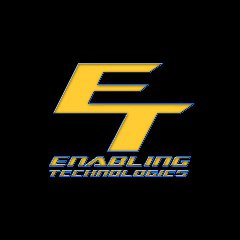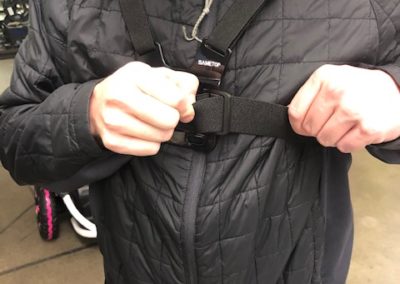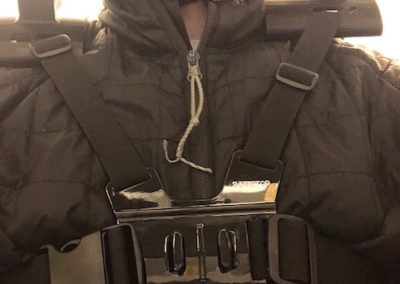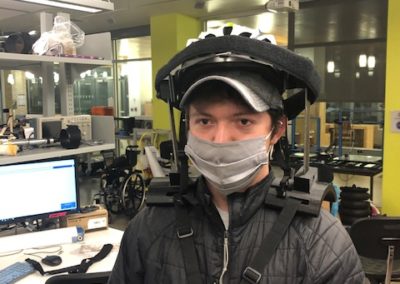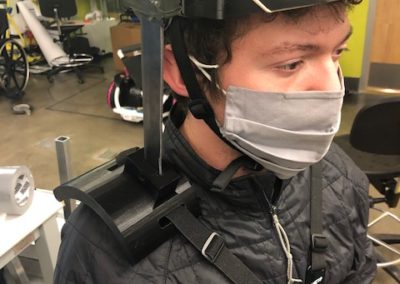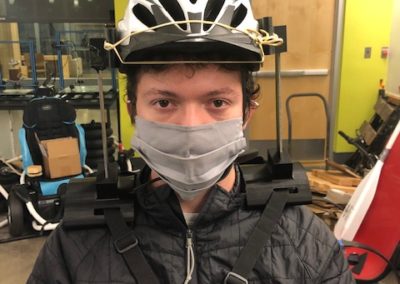S20-15c Head Support for Bi-ski User
Overview
The primary objective of this project is to design and build a head support for quadriplegic skiers. These individuals often lack the strength in their neck to support their head, making them more susceptible to whiplash or more severe injuries while skiing. The team partnered with Denver based adaptive ski equipment company, Enabling Technologies, to develop an economical and manufacturable solution to stabilize user’s head while skiing.
Enabling Technologies is one of the leading companies providing innovation and commitment to the world of adaptive sports. They produce a variety of adaptive equipment from mono and bi-skis to crutches, with a focus in winter sports. Their primary market focuses on paraplegic skiers, although there is a much smaller demographic of quadriplegic skiers that lack proper equipment to ensure a safe and fun skiing experience. Unlike paraplegic skiers, quadriplegic skiers often lack the ability to properly support their head and neck while skiing. Quadriplegic skiers also utilize the help of an instructor to help guide them down the slopes. If the skier loses control of the bi-ski, often, the instructor/trainer cannot prevent them from falling or crashing. This leads to the risk of serious injury.
The design must support the skier’s head and neck in a fashion that prevents excessive movement and whiplash while maintaining a level of comfort and safety for the individual. Design constraints specify that the support must be lightweight and compatible with Enabling Technologies’ Dynamique Bi-Ski model. In addition, the product must be adjustable in order to accommodate different users.
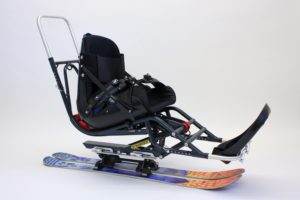
The team’s design incorporates a vertical aluminum plate that connects with durable helmet and shoulder supports. This rigid support system is fastened via a combination of straps that allow for easy removal and adjustability. For comfort, there is adequate padding and layers of fabric on the shoulder plates. Ultimately, this device empowers quadriplegics to safely participate in adaptive sports.
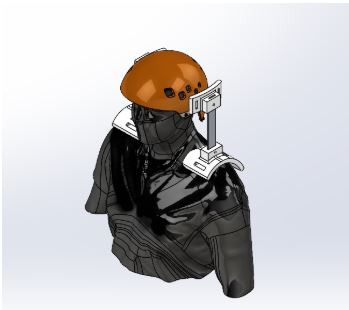
Live Zoom Chat
Use the link below to join us live from 8:00 – 10:30 a.m. on December 3. Please use passcode: 977804 Or iPhone one-tap: 13126266799,94919110406# or 16465588656,94919110406# Or Telephone: Dial: +1 312 626 6799(US Toll) or +1 646 558 8656 (US Toll) Meeting ID: 949 1911 0406
Team Members
- Michael Byckovski
- Aflah Al-Abri
- Claire Gormley
- Daniel Lutz
- Shri Nandoor
The Client
- Enabling Technologies
Acknowledgements
Project Advisor: Chelsea Salinas
Technical Advisor: Dr. Joel Bach
Donations Made by: Mines HCDS
Video
Elevator Pitch
Colorado is one of the most active states with outdoor activity at the heart of daily routine. Residents of all ages enjoy time spent outdoors walking, biking, hiking, skiing and more. Here at the Human Centered Design Studio, members combine their passion for the outdoors and interest in helping others to engineer solutions to improve the experience of those with physical limitations. These products empower all individuals to enjoy sports and the outdoors in confidence.
Our client, Enabling Technologies, reached out to HCDS at Mines to assist in the development of a manufacturable and marketable new product. The team was tasked with engineering a head support for quadriplegic bi-ski users that provided a balance between safety and comfort. The team accomplished this on both fronts. Keeping manufacturability and assembly in mind, the team iteratively designed and developed an adjustable support that accomplished weight, strength, and comfort specifications.
Design Approach
The team utilized multiple decision matrices with various design considerations to refine a product solution. The decision matrix shown below evaluated overall design options. All four design options were weighted against overarching project requirements and each requirement was weighted based on overall objectives for the project and functions of the completed product per conversations with our client.
The team designed a final product with the user in mind. Many of the specifications considered enhance the wearability of the product and overall ease of use. This includes requirements such as removability, adjustability, and weight. The team’s prototyping methods helped achieve all three criteria. Due to availability of 3D printing technology, the team iterated through multiple prototypes to ensure adequate geometry and strength. PETG infill and patterns were experimented with to find this balance.
The requirement weights and rankings for each design concept were decided as a team with client recommendations. Because the project budget is $300 and the product will eventually be incorporated in Enabling Technologies’ manufacturing process, there is not a great focus on cost reduction. The client agrees that regardless of the solution, it must be adaptable to fit the needs and sizes of different users. The client would also like to maintain its competitive advantage in the market. This is accomplished by designing a solution that is compatible with the Dynamique bi-ski model. Enhancing the safety of quadriplegic skiers is the primary goal of this project so safety is treated with the highest priority. The next performance criteria is weight. Because the support rests on the shoulders of users, it must remain lightweight. The last criterion under consideration was user preference which was the lowest priority. This encompasses the overall aesthetic of the support.

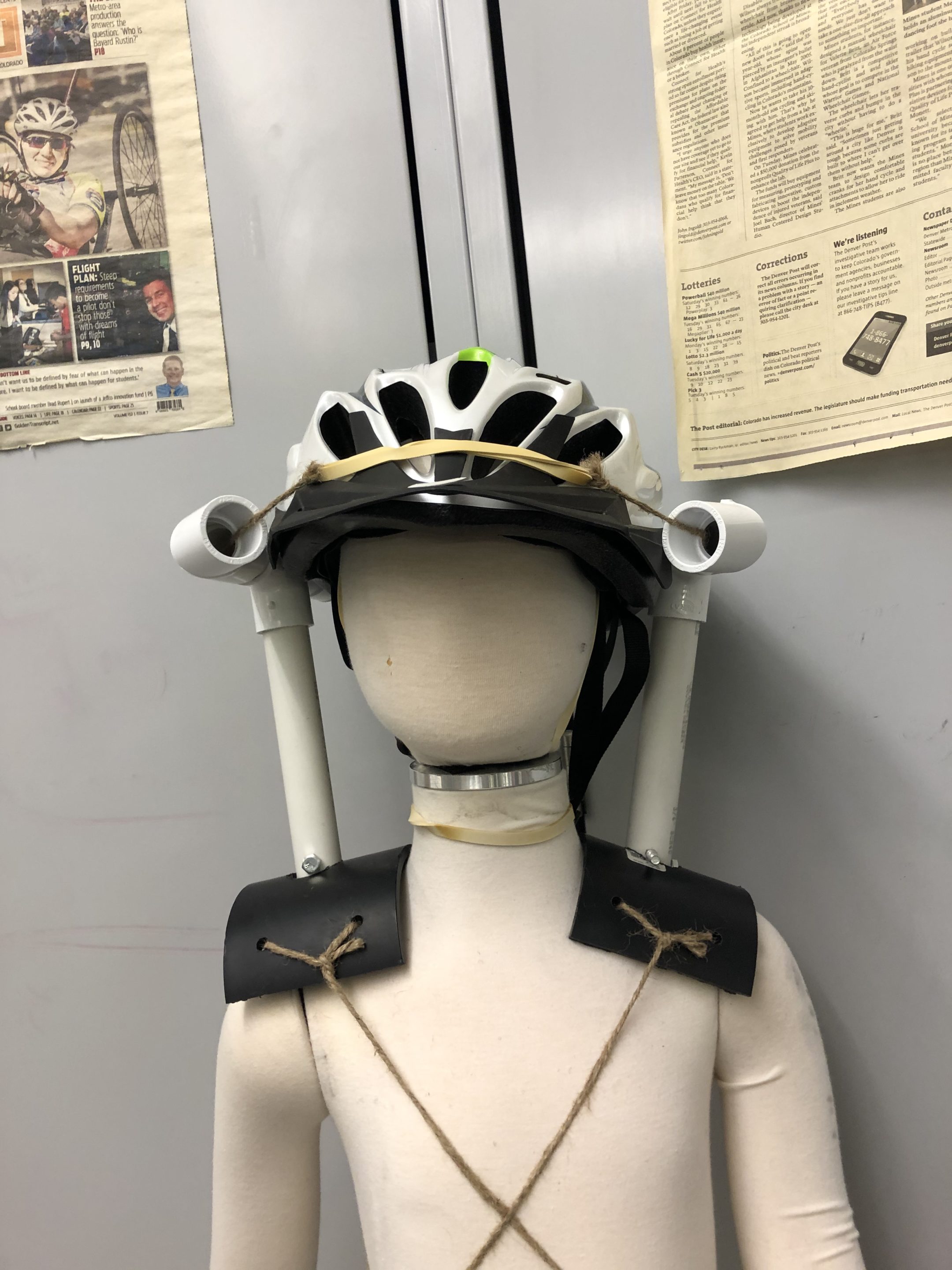

Design Solution
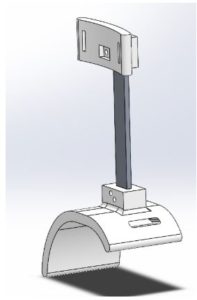
The team’s design incorporates a vertical aluminum bar that connects a helmet support and a shoulder support. The rigid support system is fastened via a combination of straps that allow for easy removal and adjustability. For comfort, there is adequate padding and layers of fabric around the shoulder plates. This design provides ample head support and allows for a safe skiing experience. In addition, engineering analysis and other modeling simulation has been conducted on the current design to ensure its safety under standard operating conditions.
The support can breakdown into four separate subsystems. These include the shoulder mount, aluminum support, helmet piece, and strap connection. Each subsystem is detailed below:
Shoulder Mount
The first subsystem is a PETG, 3D printed shoulder plate that rests on the users’ shoulder. Because this piece experiences minimal loading, it is printed using plastic. This also allows the team to more accurately design the support to contour the human shoulder. After a couple print iterations, the team identified a geometry that suits our desired user size. The overall dimensions of the shoulder mount are 4 x 5.5 x 4 inches. The piece’s cross-section is also slightly tapered with the thicker portion furthest away from the neck. This is done to account for the natural downward slope of the human shoulder. It allows our brace to stand upright. Lastly, there are slots on the front and back for the harness strap connection.
Aluminum Support
The second rigid piece is a thin vertical 6033 T5 aluminum bar that absorbs all the whiplash impact. The current dimensions are 1” x 0.25” x 8”. The team found this is the perfect balance between weight and strength. This piece also bolts into both plastic supports.
Head Piece
The third rigid part is another 3D printed plastic piece that stays in contact with the users’ ski helmet. For convenience, this piece is also printed with the durable PETG plastic. It is much smaller than the shoulder plate, with overall dimensions of 4.5 x 1.75 x 2 inches. The head piece’s primary objective is to ensure the support system stays in contact with the user’s helmet. There are also two strap slots on both sides of this piece. A strap will ultimately contour the helmet so that there is maximum contact. Straps around the upper torso will also ensure the shoulder plates stay seated correctly and the support stays aligned.
Straps
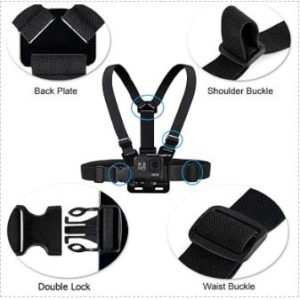 The shoulder piece is fastened to the user using straps that go under the arms and around the back. The harness purchased is specially designed to prevent strap slippage or user discomfort. The team repurposed a GoPro chest mount accessory that can be worn comfortably hours on end. The straps also prevent the shoulder mounts from moving laterally.
The shoulder piece is fastened to the user using straps that go under the arms and around the back. The harness purchased is specially designed to prevent strap slippage or user discomfort. The team repurposed a GoPro chest mount accessory that can be worn comfortably hours on end. The straps also prevent the shoulder mounts from moving laterally.
Next Steps
The remaining work on the bi-ski head support lies in additional testing. While design and manufacturing techniques were iteratively developed this semester, testing under standard operating conditions remains an outstanding task. The team will also work to incorporate additional padding for comfort around the shoulder mount and harness.
The next steps for the bi-ski head support include:
1. Attach padding to the shoulder mount underside
2. Engineer an elastic strap to attach the head supports around the helmet
3. Perform testing in standard operating conditions
4. Reinforce the plastic head piece with thicker plastic walls
With the additional modifications to the support, the team will retest a couple key ergonomic specifications to ensure that it meets or exceeds client requirements. If the head support falls short of expectations, then further design and iteration will occur so that Enabling Technology receives a usable and marketable product.
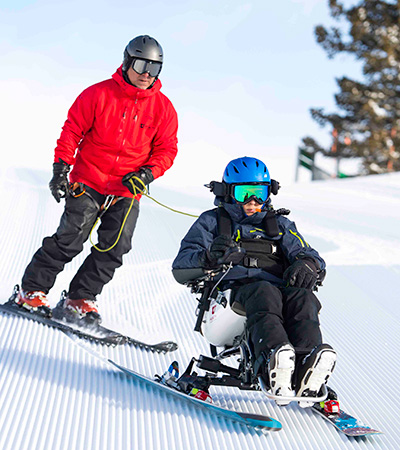
Meet the Team
Michael Byckovski

Michael Byckovski is a graduating senior in Mechanical Engineering. He is an active member of the club soccer team on campus and enjoys trips into the mountains or downtown Denver in his free time. His interest in helping others and passion for outdoor activities led him to the Human Centered Design Studio at Mines.
Aflah Al Abri

Claire Gormley
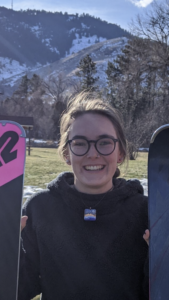 Claire Gormley is a senior in Mechanical Engineering. For the past few years, she has been volunteering at Ignite Adaptive Sports working with adaptive skiers as well as instructing at an adaptive sailing program here in Colorado. These experiences fueled her passion for the adaptive sports world and she has truly appreciated the opportunity this HCDS project has provided to design and engineer parts making adaptive sports even more accessible to all.
Claire Gormley is a senior in Mechanical Engineering. For the past few years, she has been volunteering at Ignite Adaptive Sports working with adaptive skiers as well as instructing at an adaptive sailing program here in Colorado. These experiences fueled her passion for the adaptive sports world and she has truly appreciated the opportunity this HCDS project has provided to design and engineer parts making adaptive sports even more accessible to all.
Daniel Lutz
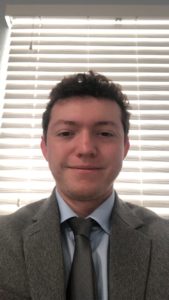 Daniel Lutz, is a senior in Mechanical Engineering at the Colorado School of Mines. He is involved in a few club and organizations, the primary two being Men’s Club Soccer and the Kappa Sigma Fraternity. He has an interest in the aerospace and biomechanical engineering fields and the manufacturing and design process surrounding them. He is set to graduate in May of 2021 and he is currently looking for employment opportunities.
Daniel Lutz, is a senior in Mechanical Engineering at the Colorado School of Mines. He is involved in a few club and organizations, the primary two being Men’s Club Soccer and the Kappa Sigma Fraternity. He has an interest in the aerospace and biomechanical engineering fields and the manufacturing and design process surrounding them. He is set to graduate in May of 2021 and he is currently looking for employment opportunities.
Shri Nandoor
 Shri Nandoor is a 4th year mechanical engineering student. Over the years he has been involved with the peer mentor program, entrepreneurship club, robotics team, sports analytics club, and AIAA on campus. His hobbies include cooking, hiking, skiing, and playing recreation sports which inspired him to pursue a senior design project with the Human Centered Design Studio. After graduation he plans on starting his career as an mechanical engineer at Lockheed Martin.
Shri Nandoor is a 4th year mechanical engineering student. Over the years he has been involved with the peer mentor program, entrepreneurship club, robotics team, sports analytics club, and AIAA on campus. His hobbies include cooking, hiking, skiing, and playing recreation sports which inspired him to pursue a senior design project with the Human Centered Design Studio. After graduation he plans on starting his career as an mechanical engineer at Lockheed Martin.
